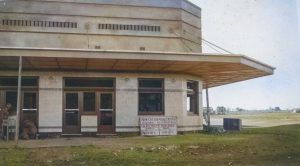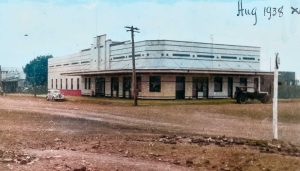The proprietor and first licensee of the Star Hotel was Mr Daniel Maher. He held the licence from 1879 until his death in 1883. Daniel Maher committed suicide – he shot himself –‘while in a state of despondency’ No wonder. His wife, Caroline, had died of ‘consumption’ (tuberculosis) in 1882 and their daughter, Elizabeth, had died of pneumonia at the age of fifteen in 1880. His oldest son, also called Daniel, was only seventeen at the time of his father’s death.
In June 1884, the executors of Mr Maher’s will advertised the Star Hotel for sale in The Sydney Morning Herald. Although an article in The Australian Town and Country Journal on 3 April 1880 had placed The Star at the bottom of the list of Cobar’s eight hotels, the advertisement described it as a ‘splendid property’ and having furnishings required to carry on a ‘first-class hotel.’ According to the ad, the hotel was on half an acre of land and consisted of 25 rooms partly of brick and partly of sawn timber. Added attractions were the brick stable and the underground tank. It also had a bark and slab stable with a smaller above ground tank fitted with a pump.
The building did not sell, but a number of people were anxious to take on the lease. The next licensee (1884-1889) was Mr Archibald McDonald. Mr McDonald was a very respectable figure, an Alderman, member of the Hospital Board, and general supporter of the community.
In 1890, Daniel Maher, son of the first licensee, took on the hotel, which he held until 1895. In 1889, Daniel had married Edith McDonald. The first of their four children was born the year he took the licence. Daniel died in 1897 of the family curse, tuberculosis. He is buried in Orange, where he had gone to seek relief and treatment. While the licence was then transferred between various people, the Mahers kept ownership of the freehold.
Edith Maher held the licence from 1898 to March 1900, transferring it to Mr William Scanlan. Mr Scanlan then had an ‘opening’ of free drinks. Mrs Maher was reported to have taken her family to ‘cooler climates’ in Orange, then known locally as ‘Cobar’s summer suburb’.
Mr Scanlan did not have the licence for long. Mr Tunney took over in September 1901. Perhaps this was due to an event in August: on the 22nd of that month, the acetylene gas plant that provided light for the hotel was not working properly. Mr Scanlan called in the assistance of one Mr Rundle. It was discovered that one of the gas taps on the main line was turned on. Mr Rundle went to turn it off– and Mr Scanlan lit a match. He lit a match. In the resulting explosion, Mr Scanlan, Mr Rundle and two other men, Mr Barry and Mr Malley were all burned about the face, hands and head. The Cobar Herald advised its readers that this was another example of “the necessity of being very careful with lights when near acetylene gas”. Indeed.
Mr Tunney was the licensee until August 1904, when it was again taken by Mrs Maher, who lived on the premises with her family. Her two daughters, Lillian and Ruby, were married from there in 1916 and 1917 respectively, and her oldest son, Harold (known as Cleve), died there in 1919 – of tuberculosis. All through this time, Mrs Maher was very popular and well-liked, running a prosperous and respectable establishment.
At various times, the hotel underwent redecoration and extensions. The most significant of these were in 1899, 1912 and 1937-1939. The work in 1899 saw the hotel bar double in size while Mrs Maher oversaw those of 1912, in which, amongst other improvements, the entire building was fitted with electric lights. Mr Scanlan may have been glad to hear of this improvement.
The early 1920s saw many hotel licences surrendered. The Liquor Licence Reduction Act plus the drastic fall in the population due to the closure of the Great Cobar and CSA Mines led to the loss of many hotels. In 1923, Mrs Maher was one of those who received compensation for relinquishing her licence (although she was dismayed at the relatively small amount she received). The resilient Mrs Maher turned the premises into a boarding house. She kept this going for several years until she, too, left Cobar to seek treatment for… tuberculosis.
Writing in The Western Age in 1928 Joe Dainer noted that the Star Hotel, now delicensed, had once been ‘the finest public bars outside Sydney’.
Would the Star ever rise again?
Onward to the Occ
In 1933, the New Occidental Gold Mine opened, bringing workers to town and seeing something of a revival in Cobar’s fortunes after the terrible depression that followed WWI. With the workers came businesses, including a major remodelling of the old Star Hotel. With much more than a facelift, it became the bright young thing of Cobar with a new ‘moderne’ face and a licence transferred across from the Meadows Hotel. Renamed the New Occidental Hotel, it quickly became ‘the Occ’, known for its up-to-date premises and accommodation. The sleek architectural style, nicknamed ‘P&O’ because it resembled the curves and prow of an ocean liner, was popular in many towns at the time, but was the only example in Cobar – a symbol of the town’s rebirth and faith in the future.
The brand-new hotel did not have an entirely smooth run. In November 1938, a storm that caused significant damage throughout the town blew over fences at the New Occidental. Its force was so great, it uprooted a large pepper tree from the yard and threw it across the road. Fortunately, there was only minor damage to the building itself. The licensee of the time was Mr Harry Okley, the son of a highly respected and long-standing Bourke and Louth publican. The tradition of family and generational proprietors was to continue at the New Occidental Hotel.
Throughout the 1940s and into the 1950s, the Occidental was one of the places to stay. Important visitors, such as the representative of the Land Board, would reside at the Occidental during the Cobar section of their tour of the districts. The hotel also took in boarders or permanent residents. The name of one of these is known because of his sad death: in June 1954, a body was found on the tracks at Redfern Station. It was that of Leslie William Humphreys, a plumber who lived at the New Occidental Hotel. How he had got onto the tracks was never explained, so his death caused not only sorrow in Cobar, but shock and bewilderment.
Over the years, the Occ had other notable patrons and proprietors. Among the former was a group of sailors.
In 1966, the hotel played host to a team of Naval rugby players, providing bed, food, and, of course, beer. The team, from the destroyer Duchess, were on a trip to promote the navy. Duchess was in Sydney for a re-fit and the ‘bush’ rugby trip was a way to keep some of the men usefully busy. They played against a team from Bourke, losing 27-13, and the next day ‘the big game’ against the local side. They lost again, 39-5. Perhaps it was partly because they had only played as a team twice before and perhaps the grassless oval that was hard as nails had something to do with it. The visit of the team got no attention at all in the local newspaper – it was overshadowed by the official opening of the CSA Mine. The mine was set for a great future, and that meant a pretty good prospect for the hotels as well.
By the late 1960s the proprietor was Reubin Payne, a former Police Sergeant and a Justice of the Peace. That made for a tightly-run and respectable pub. After Payne died, his widow, son and daughter-in-law successfully ran the Occ for many years.
A notable feature was the Duck Inn, a lounge that featured ducks that had been stuffed in more ways than one. Locally hunted, they were mounted in display boxes on the walls, staring glassily at the equally glassy-eyed drinkers.
It was also a popular live music venue with many local musos earning their chops in the beer garden. A perpetual favourite was Robert “Beeza” Josephson, named for the BSA motorbike. Beeza was famous for improvising lyrics, mostly to comment on the members of the audience and what they were up to. Many a damsel has opened the door of the Ladies only to find every eye upon her as Beeza sang soulfully of her progress back to the dance floor.
Another famous feature was the Moreton Bay fig tree on the pavement outside. So beloved was the ancient tree of both patrons and proprietors that when the power lines needed to be run down the street, a tunnel was carefully cut through the canopy so it could continue to shade the customers’ cars and shelter those who needed a breath of fresh air.
All of this life, this history, these growing traditions came to a sudden and tragic end in August 2014 when fire destroyed the hotel and took the life of firefighter Daniel Howard. These terrible losses left a hole in the street and in the hearts of the people.

The Pubs & Breweries of Cobar
Eighteen hotels are known to have existed in Cobar. Fortunately, they did not all exist at the same time as it may have been harder to get things done.





